Joy Neal Kidney's Blog, page 12
December 2, 2024
Jet Perfume
A small bottle of Jet perfume arrived from Dale Wilson for his mother’s December 4th birthday in 1943. He would graduate from Advanced Training at Roswell, New Mexico, in just a few weeks.
“Thanks for the lovely birthday present you sent me!” Leora wrote from the Minburn farm. It had arrived right on the day. She tried it out right away but was keeping it in her box of handkerchiefs to make them smell nice. A woman in those days owned a collection of hankies. Fancy ones–embroidered or with tatted lace edges–were saved for dressing up. Every birthday for years, Leora had received one from her own mother.
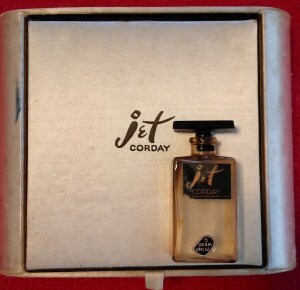
“Dale, we are sure proud of you! You are sure doing fine, and more power to you. You just do your best. You are going to like the twin-engine school, I’ll bet, after you get started, and it will be better than the single, as Delbert and the boys say they are better protected in combat.” Bombers on missions were protected by squadrons of fighter planes.
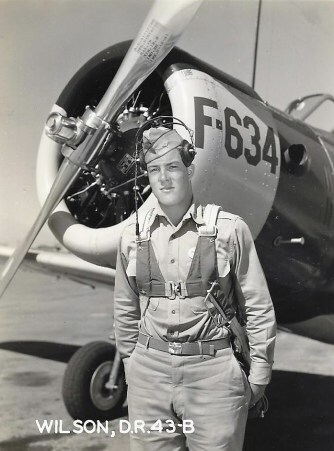
Later that month, Dale sent his folks a Roswell Army Flying School Christmas card, with silver pilot’s wings embossed on a holiday scene. Dale’s neatly penned letters were now written on Flying School stationery—a ferocious eagle diving with a torpedo, with a formation of advanced trainers flying over.
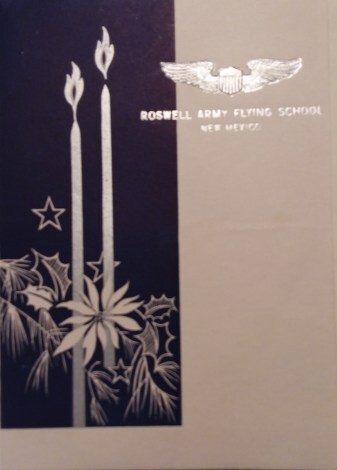
Poignant reminders of a beloved son who became a bomber pilot, whose B-25 was shot down a year later. Dale Wilson and five others on the crew have never been found.
Leora’s Letters: The Story of Love and Loss for an Iowa Family During World War II
November 25, 2024
Review of What Leora Never Knew by “MacTrish” in the United Kingdom
Reviewed in the United Kingdom on November 8, 2024
Verified Purchase I have read several of these books now about the Wilson family thanks to Joy Neal Kidney’s painstaking research and archiving of the family’s documents and letters. The last one I read told of the impact of WWII and this book takes that a stage further..Five of Leora’s sons went off to fight in the war. Two of them joined the navy and the other three became pilots..Tragedy struck all three airmen. Dale’s plane went down near Wewak, New Guinea, and his parents received a Missing In Action telegram. Daniel was shot down in [Austria] and buried there originally, and Claiborne Junior crash landed near Nordheim [Texas] and was buried in the local cemetery [Perry, Iowa]..The author points out that they’d visit the three graves and leave flowers on them, but she didn’t like to ask any questions in case she upset the older relatives. It therefore came as a shock when she discovered that only one boy was actually buried there..The book is an account of the digging for information that Joy Neal Kidney did to find out all she could about the three boys. Some of it was heart-rending. Dale’s plane ditched in the sea but there were radio broadcasts that said he’d been captured by the Japanese. This was really unsettling for the family..The research involved contacting the people who had worked with the men who gave their accounts and who often kept in touch through the years. The author also contacted the military authorities and was allowed access to a considerable body of information..As with all the books, what comes across are the strong bonds within the family. They wrote to each other often and the letters are affectionate, newsy and humorous. There are some lovely photographs too, and the boys were certainly a handsome bunch of young men..This is a moving and informative account and it’s reassuring to know that people keep the monuments and stories going to remember all the brave men who fought for their country.—–
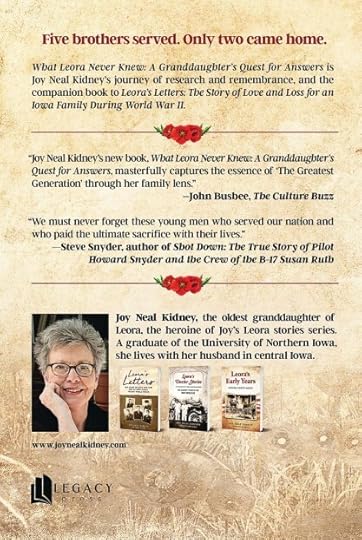
What Leora Never Knew is my journey of research into what happened to the three Wilson brothers who lost their lives during WWII.
November 22, 2024
Ben Cahill, a newly sober alcoholic with no idea how to move forward–Compelling novels by Steven Rogers
A Year in the Room by Steven Rogers
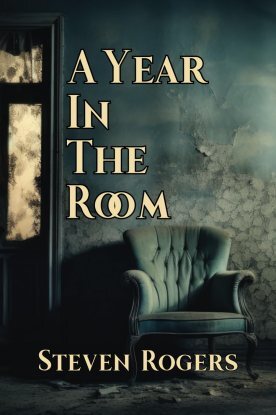
Reluctant pilgrim Ben Cahill steps off a flight from Israel facing an unrelenting list of challenges—a fractured family, no job, no place to live, and a dubious grip on his newly-found sobriety. He has no plans for the next steps in his life.
Ben starts over, settling into a small, rented room and working three part-time jobs. As his first year of recovery unfolds, Ben fights an unrelenting spiritual war against his personal demons and the consequences of his past actions. Can a chain-smoking, no-nonsense grandmother, a retired navy cook, a crusty old Scotsman, and an unexpected pilgrimage to the legendary Scottish Island of Iona, clear away the wreckage of Ben’s life and lead him to hope? Join Ben on his journey in this sequel to the award-winning novel Into the Room.
My thoughts: Ben Cahill is an alcoholic. He thought he’d made peace with God about it during a reluctant trip to Israel, but trying to patch his angry family back together and live a sober life back home isn’t working. Ben is wonderfully sarcastic and so relatable because of it. He’s “benignly abducted” by wonderful characters, some “holy rollers” from the past and present who send him on a “Pearl Itinerary” to the island of Iona. A terrific stand-alone novel is the compelling sequel to Into the Room.
Into the Room by Steven Rogers
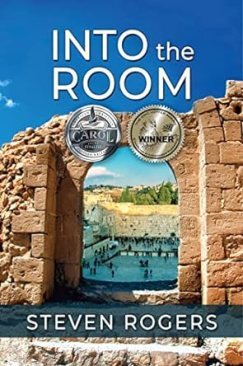 Can a journey across the Holy Land redeem a reluctant pilgrim?
Can a journey across the Holy Land redeem a reluctant pilgrim?
Ben Cahill’s life is an alcohol-saturated mess. After an insincere effort in a rehab facility, he is alienated from his family, out of work, and determined to continue his habit. To make matters worse, he finds himself on a tour of Israel, along with, as he calls them, a bunch of holy rollers.
As the trip progresses, Ben experiences the Holy Land’s major historical sites and is exposed to God’s word. He interacts with his fellow travelers, gradually learning about their faith and their lives. Along the way, Ben becomes embroiled in a spiritual war, reinforcing his guilt and, in turn, forcing him to recall his past actions and behaviors. He also begins a different journey, one that leads him to redemption and a place in God’s family.
My thoughts: A reluctant and alcoholic traveler, struggling with the mess he’s left his family in, tours the Holy Land with a bunch of “holy rollers.” This masterful and conversational story reveals a man who is rotting from the inside out, step by hesitant step, reach a hopeful transformation. It’s a powerful novel demonstrating that at the right time, all stories are worth telling. This one certainly is!
The Author, Steven Rogers
 Steven Rogers is an award-winning author and novelist. His novel Into the Room was the first place winner in the Spiritual Fiction Category for the 2022 Eric Hoffer Book Awards. The book was also named as one of three finalists in the Debut Novel category of the 2022 American Fiction Christian Writers Carol Awards. In 2023 it was a Runner-Up in the Christian Indie Awards. Steven’s second novel A Year in the Room was published in November of 2024.
Steven Rogers is an award-winning author and novelist. His novel Into the Room was the first place winner in the Spiritual Fiction Category for the 2022 Eric Hoffer Book Awards. The book was also named as one of three finalists in the Debut Novel category of the 2022 American Fiction Christian Writers Carol Awards. In 2023 it was a Runner-Up in the Christian Indie Awards. Steven’s second novel A Year in the Room was published in November of 2024.
Learn more about this author on his website.
Steven Rogers’ interview on PJNET.
November 16, 2024
JAK2 and other monkey wrenches
My Favorite Guy has added a chemotherapy capsule to his daily diet of Parkinson’s meds. A blood cancer, probably inherited, called JAK2. Octogenarianism isn’t what we’d anticipated.
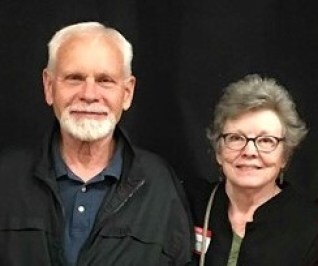 Taken a couple of years ago
Taken a couple of years agoOur life together gets a little smaller each week, learning to navigate these new medical places and learning almost a new language. Guy, a Vietnam vet, is still my caretaker, since age-related drawbacks have added to the dailiness of fibromyalgia symptoms, punctuated by diverticulitis. At some point, we may not be able to figure out who is doing the most caretaking, but we’re thankful for caring medical people and friends who keep track of us well.
Probably the hardest part for both of us is dealing with the challenges of exhaustion, some days more than others.
I have so little energy and haven’t been able to keep up with several websites I follow. I know those of you who usually get feedback from me will understand.
My next manuscript was to be finished by now, or nearly so. It looks now like it will be after the first of the year.
But God has given us both eighty years this side of heaven, fifty-eight of them together. We’re aging gratefully.
November 14, 2024
That Missing Year: 1947
Recently I read Jerry Sittzer’s book A Grace Disguised, about the aftermath–physically, emotionally, mentally, and spiritually–of suddenly losing three family members.
What agony did Grandma Leora go through, I pondered, after losing three sons and being widowed within a three-year period? Since I was a toddler during that time, I didn’t experience the days of her deepest grief. She cried only once at the cemetery, when we took flowers for Decoration Day when I was a child. Her daughters didn’t gather around her, which would have meant tears for all three. I imagine there were plenty when grandchildren weren’t with them.
There are no family letters after Grandpa Clabe’s death in late 1946, and Grandma hadn’t yet started keeping a diary. She wrote in her memoir, “I have all their letters we received and, to this day in 1980, cannot read their letters. I don’t know if I ever can, as it opens that awful feeling of grief.”
After Junior Wilson was killed in August of 1945, Clabe and Leora’s oldest son Delbert, his wife, and toddler daughter moved in with them at the Perry acreage. Another baby daughter had been born that fall, so the little house was full when Clabe died in October of 1946.
Leora’s mother, Laura Goff, had been living with her youngest son in Omaha since 1935. Leora must have also stayed with them part of the time, giving mother and daughter precious time together in that missing year, 1947.
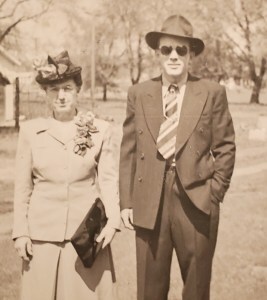 1947, leaving for Omaha, Leora and son Donald Wilson. She’s wearing a corsage. Might this have been Mother’s Day?
1947, leaving for Omaha, Leora and son Donald Wilson. She’s wearing a corsage. Might this have been Mother’s Day?Laura had been through tragedies of her own. As a child, she lost her next three siblings as children, leaving an eight-year emptiness in her life and that of her parents. Did Laura talk about that? Had her family found solace in their faith?
About losing a teacher friend to drowning? Consoling cousins who lost three children to cholera in one week?
When the Goffs lived in Minnesota, Laura bought a Bible, which she embraced while three sons served in World War I. She’d also read it twice since she moved to Omaha. Laura probably shared verses with her daughter that brought comfort to them both.
When the Goffs lived in Guthrie Center during the 1920s, Leora’s closest sister Georgia died, age 28. Two years later, the Goffs lost a daughter-in-law. They were the first two buried in the Goff plot in Guthrie Center. Devastating losses.
The Goffs lived near the Leora’s family in Dexter when they lost baby twins to whooping cough, and also Leora’s last infant. Laura made burial gowns for them. Her own last baby had died as well, buried at Audubon but also remembered in the Guthrie Center cemetery, where Sherd Goff was buried as well as Leora’s three infants.
Both mother and daughter were widowed, both had lost their homes. Both were born in Guthrie County, grew up there, with cousins still in the area. Both had loved ones buried in Guthrie Center.
They decided to return to their roots, where Laura had attended the Christian Church and was already a member of the Rebekahs. Clarence, the youngest Goff, who was a Guthrie Center graduate, worked with a builder in there. This would be their first house someone else had not lived in before, with electricity and running water and a real bathroom.
The Guthrie Center house was well underway when Leora was asked to complete a Request for Disposition of Remains for Lt. Daniel S. Wilson in October 1947. After talking over the decision with her four surviving children, they decided they just couldn’t face another funeral. And what about Dale? He would probably never be found. A month later Leora mailed the notarized form to request his permanent burial in an American Military Cemetery overseas.
In December, Delbert’s wife Evelyn wrote Leora who was still in Omaha, “Spats has gone.” This is the last mention of the Wilsons’ beloved pet.
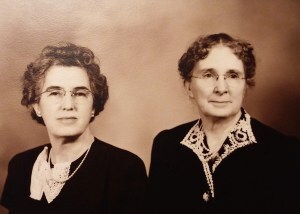 Leora Wilson and her mother, Laura Goff, taken in Omaha shortly before the moved into their new little home in Guthrie Center.
Leora Wilson and her mother, Laura Goff, taken in Omaha shortly before the moved into their new little home in Guthrie Center.The missing year, 1947. Bittersweet. Even living with deep sorrow and unthinkable losses, Leora and her mother were blessed with the comfort of each other’s company in a brand new little home of their own, with space to plant a weeping willow in the back yard, and ferns in a widow box to greet them each morning.
November 12, 2024
Questions to Ponder: What Leora Never Knew
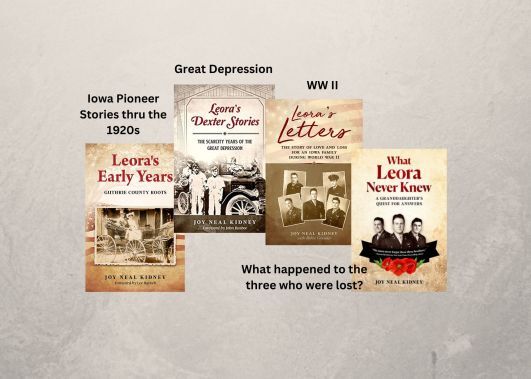
Whether you read What Leora Never Knew: A Granddaughter’s Quest for Answers alone or as part of a book club, here are some ideas to think about or to discuss with someone:
Questions to Ponder
1. “Village by village the American Graves Registration Command is covering the battle areas of the world to see if it can find any clue that may lead to an isolated grave. . .” wrote Joseph Shomon in his 1947 history, Crosses in the Wind: Graves Registration Service in the Second World War.
Were you surprised at how long it took to find where Dan Wilson was lost?
2. Do you think that two of the bomber crew may indeed have been Japanese POWs?
3. Would you rather that the bomber crew perished right away?
4. Garrett Middlebrook was a B-25 pilot of the war in New Guinea. In his book, Air Combat at 20 Feet, he wrote, “God help a nation which forgets its war dead.” He also said that “if we do not revere our war dead, we are unworthy of their sacrifice.”
Do you agree with him?
5. Michael Sledge, in his Soldier Dead: How We Recover, Identify, Bury, and Honor Our Military Fallen, said that “our national commemoration, Memorial Day, has been hijacked,” and now is a commercialized event.
Most Americans don’t know anyone close to them who was lost in combat, but could we do a better job of remembering our war casualties on Memorial Day?
6. Have you ever visited a cemetery administered by the American Battle Monuments Commission, here at home or an American cemetery abroad? Do you remember the solemn atmosphere, even if you didn’t know anyone buried there.
Sledge said, in Soldier Dead, “Few of those who walk through the rows and rows of white crosses and stars are not viscerally overwhelmed by the sheer numbers of bodies that lie beneath them.”
7. In The Rifle: Combat Stories from America’s Last WWII Veterans, Told Through an M1 Garand, Andrew Biggio said that “paying respect to veterans and honoring them enriches us as much as it ennobles them.”
How might honoring them enrich your own life?
8. Kenneth Breaux, in his Courtesies of the Heart, said that “men who died so young have little history. We define them all too often by the manner of their death.”
Do you believe that Dale, Danny, and Junior Wilson will be defined just as World War II casualties?
9. “Thin places” is a Celtic idea where the veil between this world and the next seems thinner. In Chapter 28, Joy had the feeling that her uncles in heaven took note of what she’d discovered at home in Iowa. Have you ever experienced what you might term a “thin place”?
November 7, 2024
Mitochondrial DNA
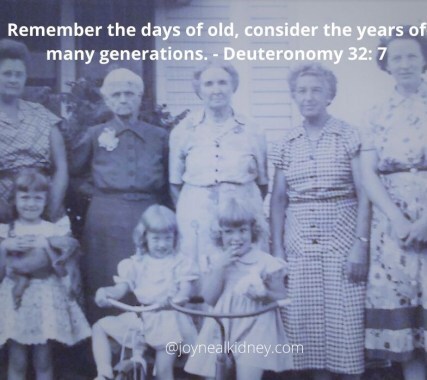 Four generations! Back: Dad’s mother Ruby Neal, her mother-in-law Nellie Neal. On the right is Mom (Doris Neal), then her mother (Leora Wilson) and her mother Laura Goff. (My great grandmothers are next to each other! Front: I’m holding puppy Candy, sis Gloria Neal, cousin Patty Wells (her mother was Dad’s sister). My motherline (also my sister’s) are the three women standing on the right.
Four generations! Back: Dad’s mother Ruby Neal, her mother-in-law Nellie Neal. On the right is Mom (Doris Neal), then her mother (Leora Wilson) and her mother Laura Goff. (My great grandmothers are next to each other! Front: I’m holding puppy Candy, sis Gloria Neal, cousin Patty Wells (her mother was Dad’s sister). My motherline (also my sister’s) are the three women standing on the right.The first time I encountered the word mitochondria was in A Wrinkle in Time, the first in a children’s science fiction trilogy by Madeleine L’Engle. Often called the “powerhouses of the cell,” in the book, Charles Wallace’s mitochondria are dying. To save him from a deadly disease, other characters travel inside one of his mitochondria. Talk about introducing kids to biology!
 Deoxyribonucleic acid (abbreviated DNA) is the molecule in a cell that carries genetic information for an organism. Known as a double helix, it’s made of two linked strands that wind around each other, reminding you of a twisted ladder.
Deoxyribonucleic acid (abbreviated DNA) is the molecule in a cell that carries genetic information for an organism. Known as a double helix, it’s made of two linked strands that wind around each other, reminding you of a twisted ladder.
Mitochondrial DNA (mtDNA or mDNA) is the DNA in mitochondria, the “powerhouses” of a cell. With rare exceptions, it’s inherited only from mothers. It can be used to track your ancestry way, way, way back through your mother’s lineage.
The human mitochondrial genome is the entirety of hereditary information contained in human mitochondria. Unlike nuclear DNA, mtDNA does not undergo meiosis and does not participate in genetic recombination events. It remains stable over generations.
Probably an article in Discover magazine was the first time I’d heard about mtDNA. It was the story about a woman who claimed to be the missing Romanov daughter.
The Missing Romanov
Tsar Nicholas II of Russia abdicated the throne during the Bolshevik Revolution of 1917. The family was placed under house arrest, then executed them in 1918. Russia’s last imperial dynasty. The Tsar, Empress Alexandria, their four daughters and one son were all believed to have perished.
Two women claimed for decades they were Anastasia, the youngest Romanov daughter. One of them was Anna Anderson who surfaced in Berlin a few years after the execution, vowing that a Bolshevik soldier had helped her survive.
Anderson’s story was made into a 1956 movie starring Ingrid Bergman. Until her death in 1984, she was considered the missing Tsarina. But when Anderson had surgery in the late 1970s, the hospital kept a tissue sample.
When the mass grave of the Romanovs was discovered in the early 1990s, the hospital gave researchers the tissue sample. The mtDNA test proved Anderson was a fraud. She was not a Romanov. Instead, her DNA matched with the Schanzkowska family. Anderson was really Franziska Schanzkowska of Poland.
Defense POW/MIA Accounting Agency
Each branch of the military maintains Casualty and Mortuary Affairs Offices. A family member of a missing person may submit DNA for use in comparison for identification purposes if they share a maternal or paternal relationship. Nuclear DNA as well as mtDNA are useful, but it gets trickier.
All persons of the same maternal line have the same mtDNA sequences. All males of the same paternal line have the same Y-STR profiles. And additional profiles from mothers, fathers, brothers, sisters, sons, and daughters can be used as well. These family reference samples are continually collected by the casualty and mortuary offices.
Dale R. Wilson and the rest of his B-25 crew, lost off New Guinea in 1943, are still missing. DNA samples from the relatives of these airmen could be useful in identifying them, if they are ever discovered.
My Motherline
I’ve been thinking about mtDNA as part of my motherline project, of pondering what we inherit from our ancestors. I’m focusing on those in a direct line of women.
You might consider your own father- or motherline. What did you inherit besides genetics?
November 5, 2024
“Just about what my mother and sister want in the way of a house,” August 1947
 Photo of the new Goff/Wilson home at 505 N. 4th Street in Guthrie Center, The Times, Guthrie Center, March 11, 1948
Photo of the new Goff/Wilson home at 505 N. 4th Street in Guthrie Center, The Times, Guthrie Center, March 11, 1948August 13, 1947
Mr. Oral Bower203 S. 5th Ave.
Guthrie Center, IowaRe: New home for Mrs. L.A. Goff
and Leora F. Wilson
Dear Mr. Bower:
You will find a sketch enclosed of just about what my mother and sister want in the way of a house. They would like to have your comments and suggestions on this; and any changes that might be necessary to make to better fit on the lot, etc. They would also appreciate an estimate of the cost for both brick veneer and frame. If agreeable to you and the city, Mrs. Wilson’s two sons will do the electric wiring. They are electricians at Perry, Iowa. We can furnish the Timken Furnace with controls and 275 Gal. oil tank. We would want a local shop to install the furnace, ducts and tank.
The following are some of the things we would like to have in the house.
52-Gal. Electric water heater8x12 chimney with flue lining.
6’6” high directional-flow warm air registers.
Return air from all rooms except kitchen and bath.
2-warm air outlets with branches in the basement.
Steel beams in basement–no partitions.
4” Rock Wool insulation in attic.
1” Balsom wool in the walls.
Weather stripping and Storm doors and windows
Composition or asbestos shingles.
basement 11 blocks deep. (use 12” wide blocks, if brick veneer)
Sod lawn on North, east and south.
Full basement except under porch and deck.
It would seem that the house should be set low on the East, so that the back of the house on the west will not be too far out of the ground. Possibly the dirt from the excavating could be used to fill in the west part of the lot. Everything including the grading and sodding should be complete.
From the above, we hope that you will be able to make up some tentative sketches and specifications and estimates. Thank you,
[signed] C.Z. Goff
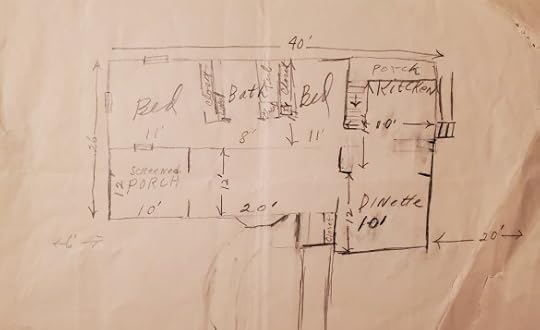 Clarence Goff’s sketch
Clarence Goff’s sketchMrs. Wilson’s sons, Delbert and Donald, did electrical work together for a while after the war.
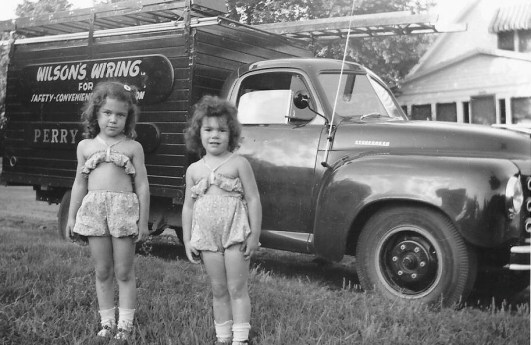 Wilson’s Wiring, Perry, Iowa, with daughters of Delbert and Evelyn Wilson, Leora Darlene and Donna Gaye, at 505 N. 4th Street in Guthrie Center, about 1948
Wilson’s Wiring, Perry, Iowa, with daughters of Delbert and Evelyn Wilson, Leora Darlene and Donna Gaye, at 505 N. 4th Street in Guthrie Center, about 1948Clarence Zenas Goff
Clarence Zenas Goff was a younger son of Laura, who was allowed to attend high school in Guthrie Center. He became the valedictorian of the Class of 1923 at age 17. In the letter above he mentions Timken Furnace, which was the company he ran in Omaha for years. In fact, during the Great Depression, when his older brothers (who’d served in WWI) couldn’t pay for their trucks, he gave them jobs.
Laura Goff’s Dexter house had been collateral for those trucks, so that was lost as well. C.Z. was 30 years old when he provided a home in Omaha for his mother, two brothers, and the motherless teenagers of one brother. And when WWII broke out, C.Z. Goff joined the Navy as an officer.
Back to the house plans in 1947. Clarence’s mother and sister also wanted a mailbox opening in the front door. I can still hear the brass flap slap shut and the mail fall onto the floor just inside the door.
November 1, 2024
Pat Paulsen for President!
Grandma Leora was so disgusted with the candidates running for president in 1968 that she quipped that she just might vote for comedian Pat Paulsen. This 6-minute video shows Paulsen just before election day.
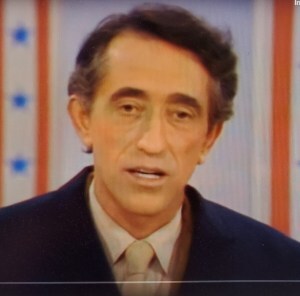
The candidates that year were Hubert Humphrey (D), Richard Nixon (R) and George Wallace (Independent). Leora was a life-long Democrat, influenced by her father, Sherd Goff.
From her diary of November 5, 1968: “Tue. 40 degrees Cloudy Calm
“ELECTION DAY
“Went to City Hall 8:30 A.M. to vote. Voted mostly Dem. some Prohibition & some Rep.
“VOTED”
She also stopped at Clark’s Barber Shop to see Mildred, who had caught her spike heel in the carpet the night before at Lodge, second stair step to the basement and had rolled all the rest of the way. She said she wasn’t hurt too much by it, but the next day her shoulder was black, Leora recorded.
She got groceries at Super Value before walking home. She watched election returns that evening until 1:30 A.M. but results weren’t announced until the next morning. Nixon won.
Loera was a busy woman and didn’t say more about it, but I guess she didn’t vote for Pat Paulsen after all.
—–
(Grandma Leora mentioned that November 7 she’d written me a letter. Guy was based at Mountain Home AFB in Idaho, so Grandma’s letters were so welcome.)
Please vote on Election Day, then pray for our nation!
October 31, 2024
Double Wedding Ring Quilt by Ruby Neal
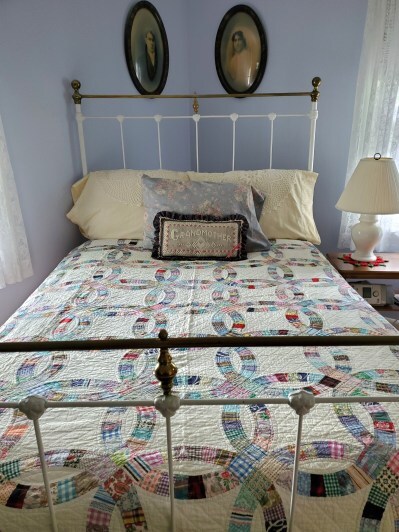 The iron bed is from the attic of the farmhouse my husband grew up in. Wedding photos of Clabe and Leora Wilson are in oval frames on the corner. Grandma Neal also crocheted the red doily under the ginger jar lamp. I made the small pillow, with GRANDMOTHER crocheting on it.
The iron bed is from the attic of the farmhouse my husband grew up in. Wedding photos of Clabe and Leora Wilson are in oval frames on the corner. Grandma Neal also crocheted the red doily under the ginger jar lamp. I made the small pillow, with GRANDMOTHER crocheting on it.Grandma Ruby Neal sent this Double Wedding Ring Quilt quilt (77″ X 88″) for our First Anniversary when Guy was stationed at Mountain Home AFB, Idaho, where we lived in a trailer court.
Grandma pieced it by hand, which isn’t easy because of the curved pieces and tight junctions. (I got to work on one years later, so I appreciated this one even more.) She and various relatives had hand-quilted it over several weeks. Made in her rural home, Dallas County, Iowa, 1977.
1985 – Part of the Historic Jordan House Quilt Show, West Des Moines, Iowa.
1991 – Stuart Care Center, when several of Grandma’s quilts were featured there.
Grandma Ruby (Blohm) Neal was known for her handwork: quilts, afghans, doilies, cross-stitched aprons, embroidery. Her own story about aprons.



